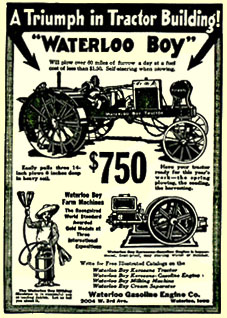| VOL. 1 |
THE IOWA FARMSTEAD |
1920 |
|||||||||||||||||||||||||||||||
| Go to page: Home, 2, 3, 4, 5, 6, 7, 8, 9, 10, 11, 12, 13, 14, 15 | |||||||||||||||||||||||||||||||||
The manufacture
and use of gas tractors has increased by leaps and bounds during the last
three years. On many Iowa farms the automobile has replaced the driving
horses. When visiting and Iowa farm recently, the writer noticed that a
reasonably good surrey was housed in the same building with the
automobile. He remarked, “I suppose you don’t use the surrey much any
more.” The reply was, “The old surrey hasn’t been hitched to since we got
the Ford three years ago.” |
Why, then, has not the tractor replaced farm work horses to the extent that the automobile has replaced driving horses? The chief reason is this: The work horse does a great variety of work under a great variety of conditions. It is a hard matter to design a tractor to do all of the work done by horses. The tractor has proven satisfactory for plowing, discing, seeding and belt work, with the exceptions that on a clay soil it gives some trouble about packing when the soil is wet, and it will not work well on hilly land. There are some tractors designed to use in cultivating corn. Most tractors can be used for pulling mowers and grain binders. The trouble in using the tractor for harvesting usually is that one man is required on the tractor and one on the binder. Then when there is no work for it to do, it will not be eating its head off. The tractor will be expected to reduce both horse and man labor. On most of the farms where it has been used successfully, it has replaced two or more horses.
|
||||||||||||||||||||||||||||||||
|
|||||||||||||||||||||||||||||||||
|
Explorations in Iowa History Project |
|||||||||||||||||||||||||||||||||
|
6 |
|||||||||||||||||||||||||||||||||
